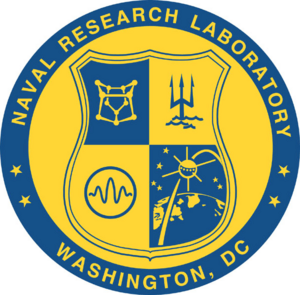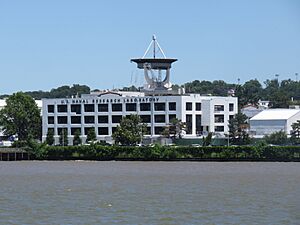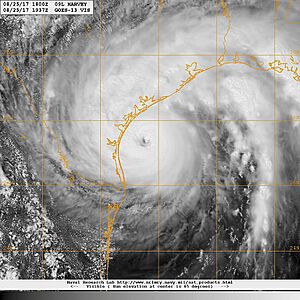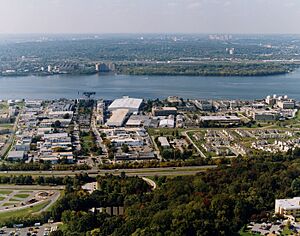United States Naval Research Laboratory facts for kids
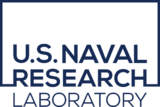 |
|||||||||||||||||
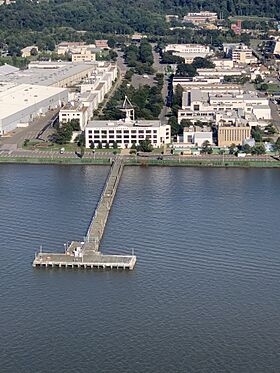
Aerial view in 2021
|
|||||||||||||||||
| Established | 1923 | ||||||||||||||||
|---|---|---|---|---|---|---|---|---|---|---|---|---|---|---|---|---|---|
| Research type | Basic and Applied Research | ||||||||||||||||
| Budget | $1.1 billion | ||||||||||||||||
|
Field of research
|
|
||||||||||||||||
| Director | Dr. Bruce Danly | ||||||||||||||||
| Staff | 2,538 civilian 86 military (2015) |
||||||||||||||||
| Location | Washington, D.C., United States 38°49′21″N 77°01′30″W / 38.82250°N 77.02500°W |
||||||||||||||||
|
|||||||||||||||||
The United States Naval Research Laboratory (NRL) is a special science lab for the United States Navy and the United States Marine Corps. It is located in Washington, D.C., and was started in 1923. The NRL does many kinds of science, from basic studies to creating new technologies and testing them. Some of its main areas of work include plasma physics (studying super-hot gases), space physics (how space works), materials science (making new materials), and electronic warfare (using electronics in defense). The NRL was one of the first government science labs in the U.S., inspired by Thomas Edison.
The NRL gets its money from research projects it works on for sponsors, not directly from the government budget. This means it earns money for its work, which helps cover its costs. In recent years, the NRL has spent about $1 billion each year on its research.
Contents
Exploring Science and Technology
The Naval Research Laboratory does a lot of different research that helps the U.S. Navy. Every year, scientists and engineers at NRL write over 1,200 research papers. These papers are shared at conferences and in science journals.
The lab has a long history of making important scientific discoveries and creating new technologies since it began in 1923. Sometimes, their inventions for military use are kept secret for many years before the public learns about them.
In 2008, the NRL was ranked as one of the top places in the U.S. for getting patents related to nanotechnology. This is the science of working with tiny materials, even smaller than a speck of dust.
Key Research Areas
NRL works on many exciting topics, such as:
- Advanced sensors for radio, light, and heat.
- Autonomous systems (robots and machines that can work by themselves).
- Computer science, cognitive science (how the mind works), and artificial intelligence (AI).
- Ways to improve communication, like radio and internet networks.
- Technology that uses focused energy, like powerful lasers.
- Devices that use electronics and light.
- Electronic warfare (using electronics to protect or attack).
- Making naval systems easier to fix, more reliable, and able to survive tough conditions.
- How the environment affects Navy equipment.
- How humans and robots work together.
- Systems for creating and understanding images.
- Keeping information safe and secure.
- Studying the geology of the ocean floor.
- Creating new materials.
- Studying weather patterns.
- Understanding sounds in the ocean.
- Studying the ocean itself.
- Physics of light.
- Physics of plasma (super-hot gas).
- Systems and technology for space.
- Technology for watching and sensing things.
- Technology for underwater use.
In 2014, NRL was also looking into things like:
- Strong armor for carrying weapons.
- Lasers that are very powerful.
- Ways to find explosives from far away.
- New types of electronics called spintronics.
- How explosive gases behave.
- Railgun technology, which uses electricity to launch objects very fast.
- Finding hidden nuclear materials.
- Devices made from graphene (a super-thin material).
- Powerful amplifiers for very high-frequency signals.
- Ways to focus sound.
- Mapping coastlines from space with lots of detail.
- Predicting weather in the Arctic.
- Analyzing and predicting tiny particles in the air around the world.
- Very dense plasmas.
- Fast-spinning stars called millisecond pulsars.
- Laser systems for sending data.
- Virtual centers for planning missions.
- Better battery technology.
- Materials that control light, called photonic crystals.
- Electronics made from carbon nanotubes.
- Electronic sensors.
- Tiny mechanical devices.
- Sensors that detect chemicals.
- Electronics made from organic materials.
- Ways to connect brains and electronics.
- Materials that can build themselves.
The lab has many special facilities for its research. In 2014, they added a very clean room for making tiny devices, quiet labs for measurements, and the Laboratory for Autonomous Systems Research (LASR).
Major Achievements
Space Science Discoveries
The NRL has a long history of building spacecraft. They created some of America's first satellites, including the second, fifth, and seventh ones to orbit Earth. They also built the first solar-powered satellite, the first spy satellite, the first weather satellite, and the first GPS satellite.
The Project Vanguard program, America's first satellite effort, had NRL design and launch a satellite in 1958. As of 2024, Vanguard I is still in orbit, making it the longest-lasting human-made satellite. Vanguard II was the first satellite to look at Earth's clouds, making it the first weather satellite. NRL's GRAB I satellite was the first U.S. spy satellite, mapping Soviet radar networks from space.
The Global Positioning System (GPS), which helps you find your way around, was invented at NRL. They tested it with their Timation satellites. The first working GPS satellite, Timation IV (NTS-II), was also built at NRL.
NRL was a pioneer in studying the sun's ultraviolet and X-ray light. They continue this work with satellites like Coriolis, launched in 2003. NRL also runs the Tactical Satellite Program, with satellites launched in 2006, 2009, and 2011.
The NRL created the first system for tracking satellites, called Minitrack. This system became the model for future satellite tracking networks. Before spy satellites, the large dish antenna on top of NRL's main building in Washington, D.C., was used for "Communication Moon Relay." This project bounced signals off the Moon for long-distance communication and to listen to Soviet transmissions during the Cold War.
NRL's work on spacecraft continues today with satellites like TacSat-4. Besides building satellites, NRL also designs and uses research tools and experiments in space. These include instruments on STPSat-5, the WISPR camera on the Parker Solar Probe, and the LASCO experiment on the Solar and Heliospheric Observatory (SOHO). NASA's Fermi Gamma-ray Space Telescope was tested at NRL. NRL scientists have also done important research on novas (exploding stars) and gamma-ray bursts.
Weather Forecasting
The Marine Meteorology Division of NRL, located in Monterey, California, helps with weather forecasting around the world. They share images from 18 weather satellites. Satellite images of big storms like hurricanes often come from NRL–MRY, as seen during Hurricane Harvey in 2017. NRL also helps create weather forecasting models, like the Hurricane Weather Research and Forecasting model released in 2007.
Materials Science Innovations
NRL has a long history of making important contributions to materials science. In the 1920s, they used X-rays to check metal parts and welds on Navy ships without damaging them. They also helped create modern ways to understand how materials break, which was used to solve problems in Navy ships, airplanes, and missiles. This knowledge is now used widely in many areas, from designing nuclear reactors to building aircraft and submarines.
NRL developed a way to make very pure GaAs crystals. These crystals are used in many modern high-frequency devices, like cell phones, satellite communication systems, and radar systems on U.S. combat aircraft and missiles. NRL's GaAs inventions were used by major companies. Pure GaAs is also used in efficient solar cells, like those on NASA's Spirit and Opportunity rovers on Mars.
NRL scientists also found hydrogen from the solar wind in moon soil samples brought back by Apollo missions.
Basic ideas for stealth technology were developed at NRL, including how certain materials can absorb radar waves. Metal treatments using chromium ion implantation, researched at NRL, almost tripled the life of Navy jet engine parts. Special coatings developed at NRL are used to line fuel tanks in the U.S. Navy, which helps prevent leaks and contamination. The same coatings are used on Los Angeles-class submarine radomes to repel water and allow radar to work soon after the submarine surfaces.
Scientists at NRL often do research on new materials, especially magnetic materials, nanomaterials (super tiny materials), and thermoplastics (plastics that can be melted and reshaped).
Radar Development
The first modern U.S. radar was invented and developed at NRL in Washington, D.C., in 1922. By 1939, NRL put the first working radar on the USS New York. This radar helped the Navy win important battles like the Battle of the Coral Sea, Battle of Midway, and Guadalcanal Campaign. NRL then continued to improve radar, including radar that could see over the horizon and better ways to display radar data. NRL's Radar Division continues to do important research for the U.S. Navy and Department of Defense.
Electronic Warfare
NRL's Tactical Electronic Warfare (TEW) Division works on research and development to support the Navy's needs in electronic warfare. This includes ways to detect enemy electronic signals, block them, and protect against enemy electronic attacks. NRL TEW covers electronic warfare for aircraft, ships, and ground forces. NRL is also responsible for the identification, friend or foe (IFF) system, which helps identify friendly aircraft and ships.
Information Security
The Information Technology Division at NRL has a group that works on information security. They developed the IP Security (IPsec) protocols, which are widely used for secure internet connections, like those used in virtual private networks (VPNs). Many projects developed by NRL become widely used without people knowing where they came from. For example, onion routing, which is the main idea behind the Tor software that helps people browse the internet anonymously, was developed at NRL.
Nuclear Research
Research into nuclear power started at NRL as early as 1939, even before the first atomic bomb. The goal was to power submarines. Methods for enriching uranium, supported by NRL during World War II, were used by the Manhattan Project and helped design the uranium enrichment plant at Oak Ridge National Laboratory. NRL is currently working on laser focusing techniques for inertial confinement fusion, a way to create energy like the sun.
Physical Sciences
The static dischargers you see on the back edges of almost all modern aircraft were first developed by NRL scientists during World War II. After the war, the lab created modern synthetic lubricants, first for Navy jet aircraft, and later adopted by commercial airlines.
In the late 1960s, NRL researched low-temperature physics. In 1967, they reached a temperature within one millionth of a degree of absolute zero, which is incredibly cold. In 1985, two NRL scientists, Herbert A. Hauptman and Jerome Karle, won the Nobel Prize. They found a way to use X-ray diffraction to figure out the structure of crystals. Their methods are now used in labs worldwide to analyze thousands of new substances every year.
More recently, NRL has published research on quantum computing, quantum dots (tiny semiconductor particles), plasma shockwaves, how liquids behave, and modeling oil spills.
NRL also has a small squadron of research aircraft called Scientific Development Squadron (VXS) 1. One of their missions, called Rampant Lion, used special instruments on planes to collect detailed 3D maps of Afghanistan, Iraq, and Colombia. This helped find natural resources like underground gas, minerals, and different types of plants.
Plasma Science
The Division of Plasma Physics studies ionized matter (gas where atoms have lost or gained electrons). NRL currently holds the world record for the most powerful rail gun projectile and the fastest human-made projectile.
Artificial Intelligence Research
NRL started the Navy Center for Applied Research in Artificial Intelligence in 1981. This center does research in artificial intelligence, cognitive science, autonomy, and how humans interact with computers. Some of their achievements include advances in how computers think, how humans and robots work together, and machine learning (where computers learn from data).
How NRL is Organized
As of 2017, the NRL was divided into different groups: four research groups, one financial group, and one executive group. Most of these groups are based in Washington, D.C. Many also have other locations, mainly at the Stennis Space Center in Mississippi or in Monterey, California.
NRL Staff
Most people who work at NRL are civilians (not military personnel) who work for the U.S. government. A smaller number are Navy sailors or officers. Almost all NRL staff are U.S. citizens. There are also some contractors who work at NRL. As of December 31, 2015, NRL had 2,540 civilian employees and 93 military personnel across all its locations.
NRL has a special pay system for its civilian employees. This allows them to pay employees based on how well they perform, rather than just how long they have worked there. Many scientists and engineers at NRL have advanced degrees. According to a 2016 report, 870 NRL civilian employees had a doctorate degree, 417 had a master's degree, and 576 had a bachelor's degree as their highest education.
The lab also hosts researchers who have just finished their PhDs. In 2013, NRL was ranked among the best places for these post-doctoral researchers to work.
Research Groups
The four main research groups at NRL are:
- The Systems Directorate (Code 5000) works on everything from basic research to engineering new technologies for the U.S. Navy. It includes divisions for Radar, Information Technology, Optical Sciences, and Tactical Electronic Warfare.
- The Materials Science and Component Technology Directorate (Code 6000) studies materials to create better and more advanced ones for the Navy. It has divisions for the Structure of Matter, Chemistry, Material Science & Technology, Computational Physics and Fluid Dynamics, Plasma Physics, Electronics Science & Technology, and Biomolecular Science & Engineering.
- The Ocean and Atmospheric Science and Technology Directorate (Code 7000) does research in areas like sounds in the ocean, remote sensing (gathering information from a distance), oceanography, marine geology, marine weather, and space science. It has divisions for Acoustics, Remote Sensing, Oceanography, Marine Geosciences, Marine Meteorology, and Space Science.
- The Naval Center for Space Technology (Code 8000) focuses on NRL technologies used in space systems. It helps with the engineering and development of space systems. It has two departments: Space Systems Development and Spacecraft Engineering.
Support Groups
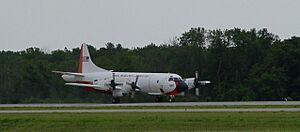
The two support groups are:
- The Executive Directorate is led by the Commander of the NRL, usually a U.S. Navy Captain. This group also manages the Scientific Development Squadron ONE (VXS-1), which provides research aircraft for NRL and other U.S. government agencies.
- The Business Operations Directorate manages the business side of NRL, supporting the science groups. It handles contracts, money management, and supplies for scientific projects.
Nanoscience Institute
In 2001, the Institute for Nanoscience was created. This institute brings together scientists from different fields to do research on tiny materials, electronics, and biology. Scientists can work for the Nanoscience Institute while also doing research for their own divisions.
Laboratory for Autonomous Systems Research
Opened in March 2012, the Laboratory for Autonomous Systems Research (LASR) is a large facility that supports research on autonomous systems. It helps with many types of research, including how autonomous systems work, how smart they are, how humans and autonomous systems interact, sensor systems, power systems, networking, and different types of platforms (like robots or drones).
LASR has special facilities and simulated environments, like a tropical rainforest, a desert, and a forest. These allow scientists to test their research in realistic conditions.
NRL Locations
The main campus of NRL is in Washington, D.C., right next to the Potomac River. It is just south of Joint Base Anacostia-Bolling.
NRL also has several other locations:
- NRL-South is at NASA's Stennis Space Center in Bay St. Louis, Mississippi. It specializes in oceanography, marine geology, and sounds in the ocean.
- NRL-Monterey is in Monterey, California, near the Naval Postgraduate School. It focuses on meteorology and atmospheric research.
- The Scientific Development Squadron (VXS) 1 is at the Patuxent River Naval Air Station in Lexington Park, Maryland. It operates many different research aircraft.
- The Chesapeake Bay Detachment (CBD) in Chesapeake Beach, Maryland, is a large site for research in radar, electronic warfare, optical devices, materials, communications, and fire research.
- Other sites like the Midway Research Center in Quantico, Virginia, and the Blossom Point Satellite Tracking and Command Station in Blossom Point, Maryland, are used by NRL's Naval Center for Space Technology.
- The Marine Corrosion Facility in Key West, Florida, is used for studying how materials corrode in the ocean.
- NRL also uses special facilities at the Brookhaven National Laboratory for studying materials with X-rays.
NRL's History
Early Days
Tools and pottery found at the NRL campus show that people lived there a very long time ago. The land became part of Washington, D.C., in 1791. Later, it was bought by the government in 1873 and became part of the Naval Gun Factory.
How NRL Started
The idea for the Naval Research Laboratory came from Thomas Edison. In 1915, he wrote that the government should have a great research lab to develop military and naval technology. Edison then helped lead a group of civilian experts who advised the U.S. Navy on science and technology. This group suggested building a modern lab for the Navy. In 1916, Congress set aside money for it, but construction was delayed until 1920.
The U.S. Naval Research Laboratory officially began on July 2, 1923. Its first two groups studied radio and underwater sound. They created communication equipment, devices to find directions, sonar, and the first working radar in the U.S. They also did basic research, helping to discover and explore the ionosphere (a layer of Earth's atmosphere). Over time, NRL grew to include more science areas, like optics, chemistry, and metallurgy.
World War II and Growth
During World War II, the NRL grew a lot. The number of employees jumped from 396 in 1941 to 4,400 in 1946. The lab focused almost entirely on applied research (solving practical problems). They made big advances in radio, radar, and sonar. They also created ways to counter enemy technology, produced new lubricants, and developed special paints and tapes for identification. A process they developed helped provide a special type of uranium needed for one of the first atomic bombs. Many new devices from wartime industries were also tested and approved for the Navy.
After World War II
After World War II, the U.S. wanted to keep the strong connection between its military and the scientific community. The Navy created the Office of Naval Research (ONR) in 1946 to support scientific research. NRL was placed under ONR's management. This change allowed NRL to focus more on long-term basic and applied research in all areas of physical sciences.
Modern Era
In 1992, another lab, the Naval Oceanographic and Atmospheric Research Laboratory (NOARL), joined NRL. This made NRL the main Navy center for research in oceanography and atmospheric sciences, including physical oceanography, marine geology, ocean acoustics, marine weather, and remote sensing of the ocean and atmosphere.
100 Years of Service
On July 2, 2023, the U.S. Naval Research Laboratory celebrated 100 years of service. Over the past century, NRL has changed how the U.S. military operates, improved its abilities, and prevented technological surprises. It has also shared important technology with industries. NRL's work has had a huge impact on the world, especially with the first U.S. radar, the world's first spy satellite, and the first working satellite of the Global Positioning System (GPS).
Environmental Concerns
The Navy started looking into environmental issues at NRL in 1984. The Maryland Department of the Environment oversees these efforts. Since the early 2010s, the Navy and the Maryland department have worked together. In 2017, they found certain chemicals called PFAS in the shallow groundwater on base. As of 2022, there are several active sites where they are cleaning up waste from things like photo processing and fire testing. There are also sites with lead contamination from old shooting ranges. In May 2021, a meeting raised concerns about very high PFAS levels in the soil at the Chesapeake Bay Detachment's fire training area.
See also
 In Spanish: Laboratorio de Investigación Naval de Estados Unidos para niños
In Spanish: Laboratorio de Investigación Naval de Estados Unidos para niños
- United States Marine Corps Warfighting Laboratory (MCWL)
- Office of Naval Research (ONR)
- Air Force Research Laboratory (AFRL)
- United States Army Research, Development and Engineering Command (RDECOM)
- Defense Advanced Research Projects Agency (DARPA)
- History of radar
- Robert Morris Page — One of the main American radar scientists
- NRLMSISE-00 — Model of the Earth's atmosphere from ground to space
- SIMDIS — 3-D Analysis and Display Toolset
- Clementine spacecraft
- National Research Libraries Alliance
- Fleet Electronic Warfare Center (FEWC)
- National Oceanic and Atmospheric Administration (NOAA)
- University-National Oceanographic Laboratory System (UNOLS)
- List of auxiliaries of the United States Navy


